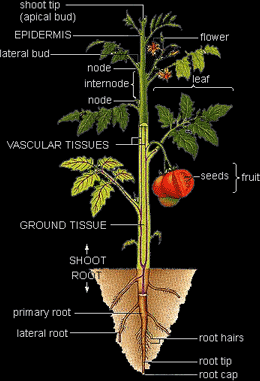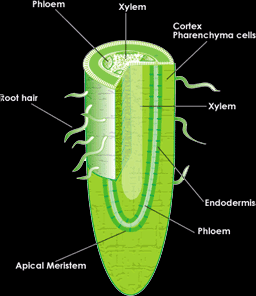Transport In Plants
Just like humans, plants have a transport system of vessels and cells that transports water, minerals and other nutrients around the plant.
|
|||||
| The diagram below shows a transverse section through a root. We can see than there are two types of hollow tubes, the xylem is the one in yellow and the phloem is the one in blue. | 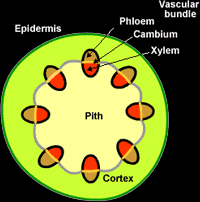 |
|
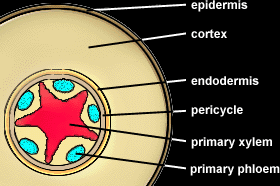 |
Each type of these tissues functions adapts differently to the other. The diagram on the right shows a transverse section of the stem. We can see that the xylem and phloem are still there, but they are arranged differently, they are both put together in an egg shaped structure separated by a cambium. |
|
Structure Of The Xylem Tissue:The xylem vessels are long hollow tubes made of dead lignified cells arranged end to end forming a continuous motion. The xylem vessel is specialised to transport water and dissolved minerals from the root up to all the other parts of the plant, and also to helps supporting the stem and strengthening it. These walls of the xylem vessel contains holes called pits which water enters through. The xylem tissue is adapted to its functions in different ways. For instance, the cell wall of the dead cells of the walls of it is made of lignin, which makes it stronger to support the stem, the fact that they are dead makes all the water absorbed by the root hair cells get transported to the leaves without being used by the cells of the vessel. The tube is also very narrow, to make it easier for the water to be transported upwards. |
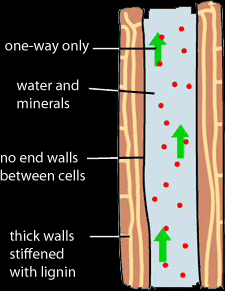 |
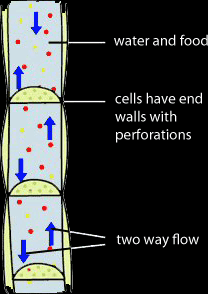 |
Structure Of The Phloem Tissue:This is a long tube that runs alongside the xylem tissue. They are made of long narrow tubes with perforated sieve plates along the thin length. The function of the phloem tissue is to transport food nutrients such as glucose and amino acids from the leaves and to all other cells of the plant, this is called translocation. Unlike the xylem, the phloem tissue is made of living cells, because as we will se later, there are several forces causing the transport of water in the xylem, but there are no forces causing the translocation, so substances need to be moved along using active uptake, which needs energy. The cells of the phloem vessels contains a cytoplasm but no nucleus, and its activities are controlled by a companion cell next to it which has a nucleus, but companion cells have no function in translocation. |
Mechanism Of Water Transport:The water reaches the leaves from the soil by several steps, starting at the root:
|
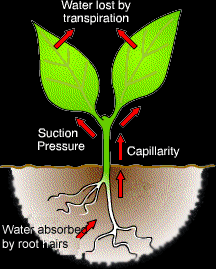 |
How Water Moves Through The Xylem:
There are three factors affecting the movement of water:
- In root hair cells, the mineral concentration is high, it helps pushing the water towards the xylem and the stem.
- Capillarity is a factor that helps in the movement of water in the xylem vessels. The water molecules are attracted to each other, as one moves upwards it pulls its neighbouring molecule with it. The molecules are also attracted to the walls of the xylem, the narrower the xylem the easier it is for water to move.
- Transpiration force is the most effective force that causes water movement. In the leaf, the water evaporates and leaves the plant through the stomata, one molecule escapes pulling the other with it, and so on, creating a suction force. You can think of it as using a straw to drink.
Factors Affecting The Transpiration Rate:
- Humidity: humidity means more water vapour in the air, which means water vapour has a higher concentration in the atmosphere than inside the leaf, so transpiration will be much slower because the diffusion of water vapour outside the leaf will be slow. The higher the humidity the slower the transpiration.
- Temperature: when the temperature is high, molecules move faster and evaporate faster, so transpiration rate increases. The higher the temperature the faster the transpiration.
- Wind speed: when the wind is fast, it takes humid air away from around the leaf, making the diffusion rate faster, so the faster the wind the faster the transpiration.
- Light: when light intensity is high, the stomata will open to let Carbon dioxide in for photosynthesis, the water vapour has an easier chance to escape. In the dark the stomata are closed, the transpiration rate is very slow.
Wilting occurs when the transpiration rate is faster than the rate of water absorption. The amount of water in the plant keeps on decreasing. The water content of cells decreases and cells turn from turgid to flaccid. The leaves shrink and the plant will eventually die.
Translocation:
This is the transport of organic food such as sucrose and amino acids in the plant through the phloem vessels.
Glucose, the product of photosynthesis is the most important food of the plant. Because from it, it makes most of its other nutrients. Glucose is converted into an other more complex sugar called sucrose. Sucrose in the leaves enter the phloem vessels. The phloem transports it to every other part of the plant where it is made use of. Amino acids are also transported in the phloem.
Sucrose and amino acids are transported to every tissue of the plant, each cell use it in a different way. Root cells convert sucrose into glucose for respiration and store it. Growing cells make cellulose for cell walls from sucrose and use the amino acids to make proteins for growth. And fruits use the sucrose to make the attractive scent and tasty nectar to attract insects.
The areas of the plant where sucrose is made, are called sources, and where they are delivered to and made use of are called sinks.
Pesticides And Insecticides:
Some insects and pests feed on plants and harm them. A way to prevent this problem is to spray the plant with insecticides and pesticides. But the problem here is that these chemicals also kill insects and pests that are useful to the plant. This is why systemic pesticides are used. When sprayed, they are absorbed inside the plant and distributed all over the plant. When the harmful insects and pests eat a part of the plant, they eat the poison with it, thus they die and harmless ones are safe.
Adaptation Of Special Plants:
Desert Cactus:
|
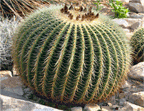 |
Pond Plants:
|
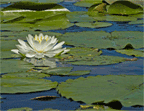 |
